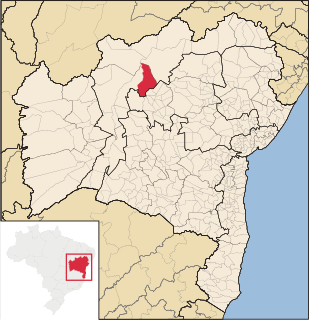| Feira da Mata Município de Feira da Mata | |
|---|---|
| Municipality | |
 Location of Feira da Mata in Bahia | |
| Coordinates: 14°12′25″S44°16′51″W / 14.20694°S 44.28083°W Coordinates: 14°12′25″S44°16′51″W / 14.20694°S 44.28083°W | |
| Country | |
| Region | Northeast |
| State | |
| Founded | 1989 |
| Government | |
| • Mayor | Alex Ronan Viana Mota |
| Area | |
| • Total | 1,176.105 km2 (454.097 sq mi) |
| Elevation | 497 m (1,631 ft) |
| Population (2014) | |
| • Total | 5,911 |
| • Density | 5.0/km2 (13/sq mi) |
| Demonym(s) | Matense |
| Time zone | BRT (UTC-3) |
Feira da Mata is a municipality in the state of Bahia in the North-East region of Brazil. Feira da Mata covers 1,176.105 km2 (454.097 sq mi), and has a population of 5,911 with a population density of 5 inhabitants per square kilometer. It was originally part of Carinhanha, but became an independent municipality in 1989. [1]

The municipalities of Brazil are administrative divisions of the Brazilian states. At present, Brazil has 5,570 municipalities, making the average municipality population 34,361. The average state in Brazil has 214 municipalities. Roraima is the least subdivided state, with 15 municipalities, while Minas Gerais is the most subdivided state, with 853.

The Federative Republic of Brazil is a union of 27 federated units : 26 states and one federal district. The states are generally based on historical, conventional borders which have developed over time. The Federal District cannot be divided into municipalities, according to the Brazilian Constitution, the Federal District assumes the same constitutional and legal powers, attributions and obligations of the states and municipalities, instead, it is divided by administrative regions.

Bahia is one of the 26 states of Brazil and is located in the northeastern part of the country on the Atlantic coast. It is the 4th-largest Brazilian state by population and the 5th-largest by area. Bahia's capital is the city of Salvador, located on a spit of land separating the Bay of All Saints from the Atlantic. Once a monarchial stronghold dominated by agricultural, slaving, and ranching interests, Bahia is now a major manufacturing center whose last three elections have been dominated by the Workers' Party.
Feira da Mata is located at the junction of BA-601 and BA-594. It is 964 kilometres (599 mi) from the state capital of Bahia, Salvador. The Carinhanha River forms the southern border of the municipality, which is also the border between the states of Bahia and Minas Gerais. [1]

Salvador, also known as São Salvador da Bahia de Todos os Santos is the capital of the Brazilian state of Bahia. With 2.9 million people (2017), it is the largest city proper in the Northeast Region and the 4th largest city proper in the country, after São Paulo, Rio de Janeiro and Brasília.

The Carinhanha River is a river of Bahia and Minas Gerais states in eastern Brazil.

Minas Gerais is a state in the north of Southeastern Brazil. It ranks as the second most populous, the third by gross domestic product (GDP), and the fourth largest by area in the country. The state's capital and largest city, Belo Horizonte, is a major urban and finance center in Latin America, and the sixth largest municipality in Brazil, after the cities of São Paulo, Rio de Janeiro, Salvador, Brasilia and Fortaleza, but its metropolitan area is the third largest in Brazil with just over 5,500,000 inhabitants, after those of São Paulo and Rio de Janeiro. Nine Brazilian presidents were born in Minas Gerais, the most of any state.
Feira da Mata was originally home to the Kayapo people. Manuel Nunes Viana expelled the Kayapo population in the early 18th century and settled in the area. [1]



















